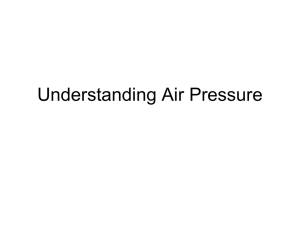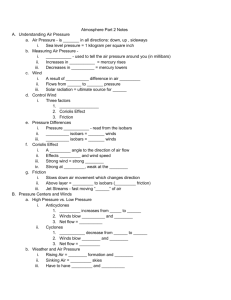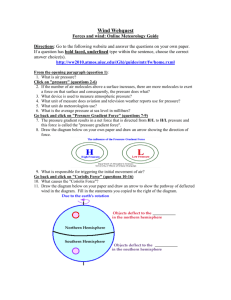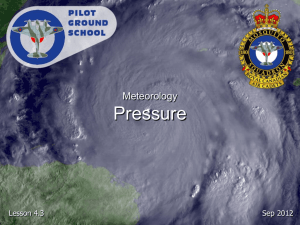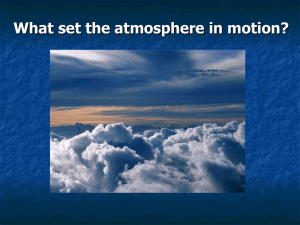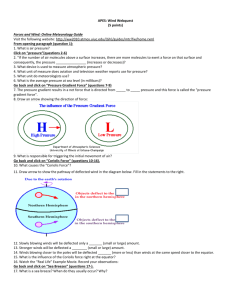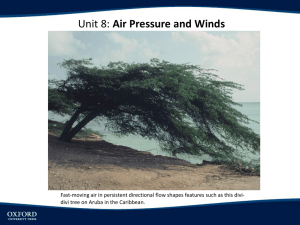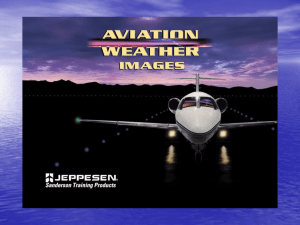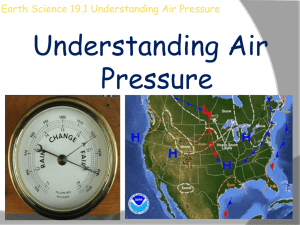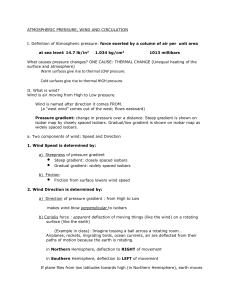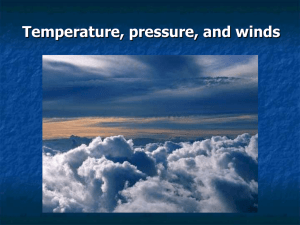Chapter 19: Air Pressure and Wind
advertisement
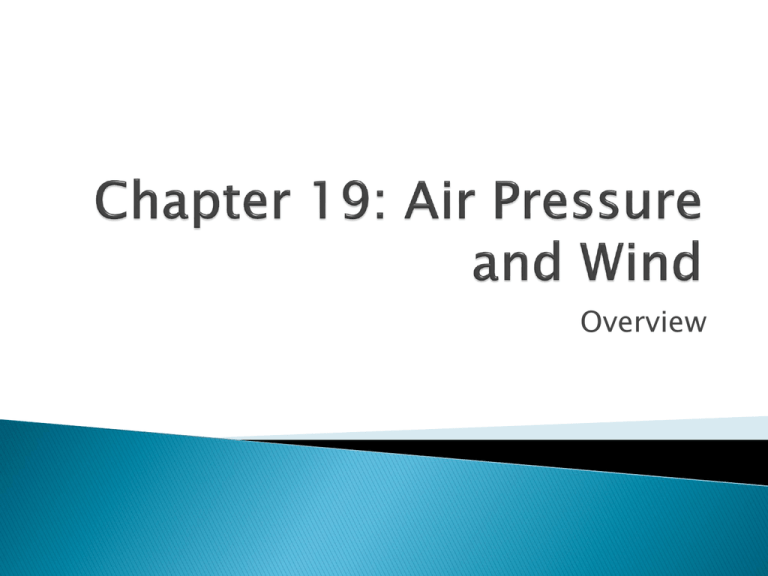
Overview Air pressure is simply the pressure exerted by the weight of air above Air pressure is exerted in all directions— down, up, and sideways The air pressure pushing down on an object exactly balances the air pressure pushing up on the object Barometer – device used for measuring air pressure When air pressure increases, the mercury in the tube rises; when air pressure decreases, so does the height of the mercury column Scientists will often use the more portable aneroid barometer to record changes over time of air pressure Wind is the result of horizontal differences in air pressure Air flows from areas of higher pressure to areas of lower pressure Wind is nature’s way of balancing out pressure inequalities The unequal heating of Earth’s surface generates pressure differences Solar radiation is the ultimate energy source for most wind If Earth did not rotate, and if there were no friction between moving air and Earth’s surface, air would flow in a straight line from high to low pressure areas Three factors combine to control wind: pressure differences, the Coriolis effect, and friction Wind is created from differences in pressure—the greater these differences are, the greater the wind speed is Over Earth’s surface, variations in air pressure are determined from barometric readings taken at hundreds of weather stations Pressure Gradient – the amount of pressure change occurring over a given distance Equal pressures are connected on a map using isobars Closely spaced isobars indicate a steep pressure gradient and high winds Widely spaced isobars indicate a weak pressure gradient and light winds The pressure gradient is the driving force of wind Coriolis Effect – the apparent deflective force of earth’s rotation on all free-moving objects All free-moving objects or fluids, including the wind, are deflected to the right of their path in the Northern Hemisphere; in the Southern Hemisphere, they are deflected to the left This deflection: 1) is always directed at right angles to the direction of airflow; 2) affects only wind direction and not wind speed; 3) is affected by wind speed—the stronger the wind, the greater the deflection; and 4) is strongest at the poles and weakens toward the equator, becoming nonexistent at the equator The effect of friction on wind is important only within a few kilometers of Earth’s surface Friction acts to slow air movement, which changes wind direction When air is above the friction layer, the pressure gradient causes air to move across isobars The most prominent features of airflow above the friction layer are jet streams Jet Streams – fast-moving rivers of air that travel between 120 to 240 kilometers per hour in a west-to-east direction The roughness of the terrain determines the angle of airflow across the isobars; the smoother the terrain, the smaller the angle of airflow Slower wind speeds caused by friction decrease the Coriolis effect Cyclones – centers of low pressure Anticyclones – centers of high pressure In cyclones, pressure decreases from the outer isobars toward the center In anticyclones, the values of the isobars increase from the outside toward the center When the pressure gradient and the Coriolis effect are applied to pressure centers in the Northern Hemisphere, wind blows counterclockwise around a low and clockwise around a high In either hemisphere, friction causes a net flow of air inward around a cyclone and a net flow outward around an anticyclone The usual “villain” in weather reports is the low-pressure center The underlying cause of wind is the unequal heating of Earth’s surface The atmosphere balances these differences by acting as a giant heattransfer system The system (atmosphere) moves warm air toward high latitudes and cool air toward the equator Trade Winds – two belts of winds that blow almost constantly from easterly directions and are located on the north and south sides of subtropical highs Westerlies – dominant west-to-east motion of the atmosphere that characterizes the regions on the poleward side of the subtropical highs Polar Easterlies – winds that blow from the polar high toward the subpolar low Polar Front – stormy frontal zone separating cold air masses of polar origin from warm air masses of tropical origin Where landmasses break up the ocean surface, large seasonal temperature differences disrupt the global pattern of pressure zones in the atmosphere Large landmasses can become cold in the winter when a seasonal highpressure system develops, and the surface airflow will be directed off the land Monsoons – seasonal reversals of wind direction associated with large continents, especially Asia; in the winter, the wind blows from land to sea, and in the summer, the wind blows from sea to land The local winds are caused either by topographic effects or by variations in surface composition— land and water—in the immediate area During warm summer months, coastal land is heated more intensely than the water, producing an area of low pressure which the cooler ocean air moves into fill, creating a breeze in the afternoon (sea breeze); at night the reverse may take place (land breeze) The same happens in the mountains, with the air from the valley coming up to replace the air from the mountain slopes (valley breeze); at night the reverse takes place (mountain breeze) Sea and Land Two basic wind measurements—direction and speed—are especially important to the meteorologist Winds are always labeled by the direction from which they blow The wind vane is the instrument used to determine wind direction Prevailing Wind – when wind consistently blows more often from one direction than from any other In the United States, the westerlies consistently move weather from west to east across the continent Anemometer – device to measure wind speed At irregular intervals of three to seven years, the warm countercurrents, along the coasts of Peru and Ecuador, become unusually strong and replace normally cold offshore waters with warm equatorial waters – El Niño The warm waters block the nutrients from reaching the surface waters, causing many fish to die off, and greatly affects the fishing industries of Peru and Ecuador Some inland areas that are normally arid get an abnormal amount of rain, increasing their crop production These episodes mostly effect the eastern tropical Pacific, but is a part of the global circulation and affects the weather all over the world The opposite of El Niño is an atmospheric phenomenon known as La Niña Researchers have come to recognize that when surface temperatures in the eastern Pacific are colder than average, a La Niña event is triggered that has a distinctive set of weather patterns A typical La Niña winter blows colder than normal air over the Pacific Northwest (with more precipitation) and the Northern Great Plains It warms much of the rest of the United States Areas dominated by the convergent Trade winds (equatorial low) have mainly rain forests and abundant precipitation Areas dominated by the subtropical highpressure cells are regions of extensive deserts The interiors of large land masses commonly experience decreased precipitation You will be able to explain much about global precipitation through your knowledge of global winds and pressure systems Read Chapter 19 (pg. 532-549) Do Chapter 19 Assessment ◦ #1-29 (pg. 553-554) ◦ # 1-6 (pg. 555)
